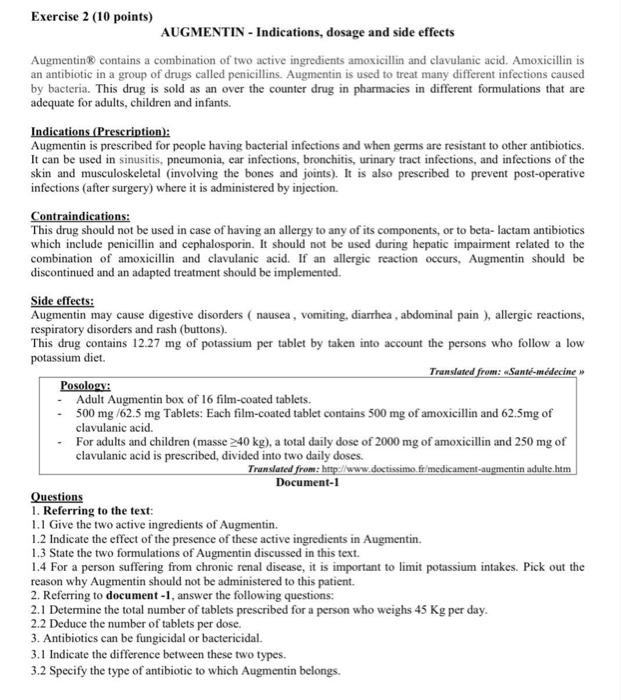Exercise 2 (10 points) AUGMENTIN - Indications, dosage and side effects Augmentin contains a combination of two active ingredients amoxicillin and clavulanic acid. Amoxicillin is an antibiotic in a group of drugs called penicillins. Augmentin is used to treat many different infections caused by bacteria. This drug is sold as an over the counter drug in pharmacies in different formulations that are adequate for adults, children and infants. Indications (Prescription): Augmentin is prescribed for people having bacterial infections and when germs are resistant to other antibiotics. It can be used in sinusitis, pneumonia, ear infections, bronchitis, urinary tract infections, and infections of the skin and musculoskeletal (involving the bones and joints). It is also prescribed to prevent post-operative infections (after surgery) where it is administered by injection Contraindications: This drug should not be used in case of having an allergy to any of its components, or to beta-lactam antibiotics which include penicillin and cephalosporin. It should not be used during hepatic impairment related to the combination of amoxicillin and clavulanic acid. If an allergic reaction occurs. Augmentin should be discontinued and an adapted treatment should be implemented. Side effects: Augmentin may cause digestive disorders ( nausea, vomiting, diarrhea, abdominal pain ), allergic reactions, respiratory disorders and rash (buttons). This drug contains 12.27 mg of potassium per tablet by taken into account the persons who follow a low potassium diet. Translated from: Santi-mdecine Posology: Adult Augmentin box of 16 film-coated tablets. 500 mg/62.5 mg Tablets: Each film-coated tablet contains 500 mg of amoxicillin and 62.5mg of clavulanic acid. For adults and children (masse 240 kg), a total daily dose of 2000 mg of amoxicillin and 250 mg of clavulanic acid is prescribed, divided into two daily doses. Translated from: http://www.doctissimo.fr medicament-augmentin adulte.htm Document-1 Questions 1. Referring to the text: 1.1 Give the two active ingredients of Augmentin. 1.2 Indicate the effect of the presence of these active ingredients in Augmentin. 1.3 State the two formulations of Augmentin discussed in this text. 1.4 For a person suffering from chronic renal disease, it is important to limit potassium intakes. Pick out the reason why Augmentin should not be administered to this patient. 2. Referring to document -1, answer the following questions: 2.1 Determine the total number of tablets prescribed for a person who weighs 45 Kg per day. 2.2 Deduce the number of tablets per dose. 3. Antibiotics can be fungicidal or bactericidal. 3.1 Indicate the difference between these two types. 3.2 Specify the type of antibiotic to which Augmentin belongs. Exercise 2 (10 points) AUGMENTIN - Indications, dosage and side effects Augmentin contains a combination of two active ingredients amoxicillin and clavulanic acid. Amoxicillin is an antibiotic in a group of drugs called penicillins. Augmentin is used to treat many different infections caused by bacteria. This drug is sold as an over the counter drug in pharmacies in different formulations that are adequate for adults, children and infants. Indications (Prescription): Augmentin is prescribed for people having bacterial infections and when germs are resistant to other antibiotics. It can be used in sinusitis, pneumonia, ear infections, bronchitis, urinary tract infections, and infections of the skin and musculoskeletal (involving the bones and joints). It is also prescribed to prevent post-operative infections (after surgery) where it is administered by injection Contraindications: This drug should not be used in case of having an allergy to any of its components, or to beta-lactam antibiotics which include penicillin and cephalosporin. It should not be used during hepatic impairment related to the combination of amoxicillin and clavulanic acid. If an allergic reaction occurs. Augmentin should be discontinued and an adapted treatment should be implemented. Side effects: Augmentin may cause digestive disorders ( nausea, vomiting, diarrhea, abdominal pain ), allergic reactions, respiratory disorders and rash (buttons). This drug contains 12.27 mg of potassium per tablet by taken into account the persons who follow a low potassium diet. Translated from: Santi-mdecine Posology: Adult Augmentin box of 16 film-coated tablets. 500 mg/62.5 mg Tablets: Each film-coated tablet contains 500 mg of amoxicillin and 62.5mg of clavulanic acid. For adults and children (masse 240 kg), a total daily dose of 2000 mg of amoxicillin and 250 mg of clavulanic acid is prescribed, divided into two daily doses. Translated from: http://www.doctissimo.fr medicament-augmentin adulte.htm Document-1 Questions 1. Referring to the text: 1.1 Give the two active ingredients of Augmentin. 1.2 Indicate the effect of the presence of these active ingredients in Augmentin. 1.3 State the two formulations of Augmentin discussed in this text. 1.4 For a person suffering from chronic renal disease, it is important to limit potassium intakes. Pick out the reason why Augmentin should not be administered to this patient. 2. Referring to document -1, answer the following questions: 2.1 Determine the total number of tablets prescribed for a person who weighs 45 Kg per day. 2.2 Deduce the number of tablets per dose. 3. Antibiotics can be fungicidal or bactericidal. 3.1 Indicate the difference between these two types. 3.2 Specify the type of antibiotic to which Augmentin belongs







